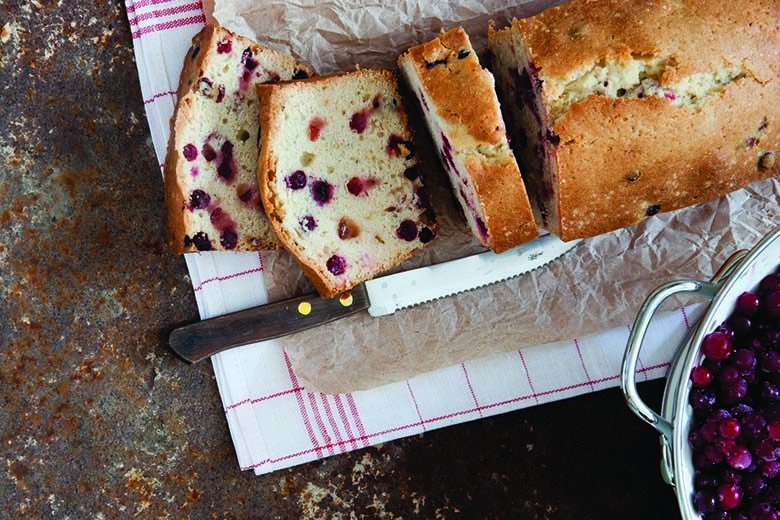
Tis the season to bake, and one of the easiest ways to participate is by whipping up a loaf of quick bread. These breads are called “quick” because they do not contain yeast, so they can be mixed and baked without waiting on the rising process. Instead, eggs, baking powder or baking soda (or a combination) are used as the leavener for classics like muffins, biscuits, scones, and banana, pumpkin and zucchini breads.
Nutrient-dense ingredients: Part of the fun of baking is making a recipe your own. With a conventional banana bread or blueberry muffin recipe, substitute up to half the fat, such as butter or oil, with cooked sweet potatoes, bananas, canned pumpkin or cooked lentil puree. Then, decrease the sugar in the recipe by a quarter. To make lentil puree, pulse 1 cup of cooked lentils and ¼ cup of water in a food processor. Nut or seed butters can replace butter or oil in quick bread recipes; substitute up to half the fat in the recipe with peanut butter, almond butter, tahini or another nut or seed butter.
Sweet switches: Some sweeteners such as honey, maple syrup and agave can add trace amounts of nutrients that aren’t found in granular sugar. Additionally, honey is a natural humectant, meaning it will help keep baked goods moist. Avoid serving any foods containing honey to children under 12 months of age due to the risk of botulism. Each of these substitutes replaces 1 cup of granulated sugar:
- 1 cup maple syrup
- ¾ cup honey
- ⅔ cup agave syrup
Decrease other liquid ingredients in the recipe by 2 to 4 tablespoons per 1 cup substitution. For example, if a recipe calls for 1 cup of sugar, substitute ¾ cup of honey and decrease the milk, water or juice in the recipe by 2 tablespoons. To help heavy baked goods rise, add ½ teaspoon of baking soda. Lower the oven temperature y 25 degrees Fahrenheit to prevent over-browning.
Nut or seed butters can replace butter or oil in quick bread recipes; substitute up to half the fat in the recipe with peanut butter, almond butter, tahini or another nut or seed butter.
Yogurt additions: To increase protein and decrease fat, use 2% plain Greek yogurt. Instead of 1 cup of butter, use ½ cup butter plus ¼ cup yogurt. For 1 cup of oil, use ⅓ cup oil plus ⅔ cup yogurt.
Go gluten-free: While nut-based and whole-grain gluten-free flours can add flavor and nutrition, they cannot be substituted 1:1 for regular all-purpose flour. However, mixtures of gluten-free flours can be used. When using a gluten-free all-purpose flour blend, a portion of it often can be replaced with a portion of another gluten-free flour. For example, substitute buckwheat flour for a quarter of the called-for gluten-free all-purpose flour to produce an earthy, hearty flavor.
Plant-based substitutes: Whether the recipe calls for milk, buttermilk or evaporated milk, the grocery store’s dairy case is stocked with unsweetened plant-based alternatives and shelf-stable products are available, too. Review their Nutrition Facts labels for added sugars and look for products that are fortified with calcium and vitamin D. When substituting a plant-based beverage for regular cow’s milk, a 1:1 ratio can generally be used, keeping in mind that the baked muffins and quick breads will generally be denser in texture. When a recipe calls for 1 cup buttermilk, use 1 cup oat or hemp milk plus 1 tablespoon vinegar or lemon juice. To make evaporated milk, simmer 2 cups of any plant-based beverage over medium heat, stirring constantly until it reaches your desired consistency (usually yields 1 cup).
Bonus dry milk powder: For an easy, inexpensive way to make muffins, scones and quick breads taste better and have slightly more protein, add 1 tablespoon of dry milk powder to the dry ingredients of a recipe. As a bonus, this yields a more golden crust and a more tender result.
References
Baking Tips and Tricks. Nature Nate’s Honey Co. website. https://www.naturenates.com/tips-and-tricks/. Accessed July 20, 2021.
Make Your Baking Better With Milk Powder. MyRecipes website. https://www.myrecipes.com/cooking-method/baking-recipes/use-milk-powder-baking. Updated April 10, 2019. Accessed June 14, 2021.
Plant-Based Baking: Using Dairy Alternatives. Pacific Foods website. https://www.pacificfoods.com/plant-based-beverages/. Accessed June 14, 2021.
Quick Breads. University of Kentucky College of Agriculture website. https://fcs-hes.ca.uky.edu/sites/fcs-hes.ca.uky.edu/files/2ssc_qb_pub.pdf. Published December 2010. Accessed June 14, 2021.

